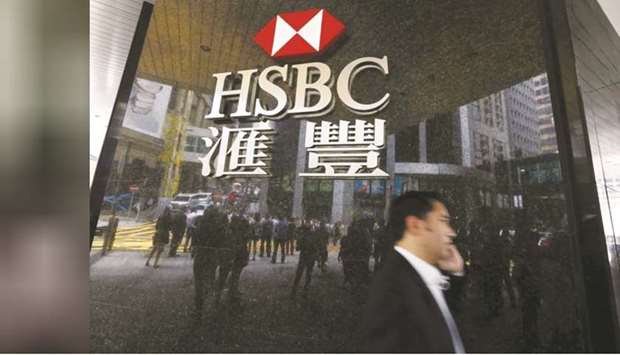The cost of the deadly coronavirus is starting to add up for banks across Asia.
Lenders from HSBC Holdings Plc to the three biggest banks in Singapore have warned that the virus and related economic slowdown will likely force them to set aside more money for soured loans this year.
In China alone, S&P Global Ratings estimates the level of non-performing loans may triple, an increase of $800bn.
“With dark clouds facing us, we need to be cautious,” Wee Ee Cheong, chief executive officer of Singapore-based United Overseas Bank Ltd said yesterday after the bank forecast an uptick in credit costs due to the virus.
The ability for Asian lenders to weather the coronavirus storm has implications for the global financial system.
Asia accounts for a bigger share of pretax banking profits than any other region, according to a report from McKinsey & Co Inc.
While Chinese banks will bear the brunt of the losses from the virus outbreak, foreign lenders with operations in the region also face higher loan losses and lower revenue as cases mount in countries like Japan and South Korea, and big-spending Chinese tourists stay home.
HSBC, which generated half its 2019 revenue in Asia, said in the most extreme scenario, in which the virus continues into the second half of 2020, it could see $600mn in additional loan losses.
Banks in Hong Kong, HSBC’s biggest market, have temporarily shut nearly 30% of their branches amid the outbreak that has claimed more than 2,200 lives in China.
Other foreign banks with sizeable operations in Asia include Standard Chartered Plc and Citigroup Inc.
Bank of East Asia Ltd, the Hong Kong lender with the most exposure to mainland China, estimated a deterioration of 10-20 basis points in credit costs in Hong Kong because of the virus outbreak, co-chief executive officer Adrian Li told reporters on Wednesday.
The estimates assume that the virus peaks between April and the summer, with the economy recovering as early as the second half.
“There will be some pressure on our portfolio, in particular small- and medium-sized businesses and unsecured lending, but we believe this to be manageable,” Li said. “We are confident that the bank is well-prepared to weather these short-term challenges.”
Singapore’s three biggest banks cautioned that the virus outbreak may have an impact on revenue and provisions.
DBS Group Holdings Ltd expects a 1%-2% drop in revenue from the virus.
UOB, the No 3 bank, forecast a “slight uptick” in credit costs given “current conditions.” Oversea-Chinese Banking Corp, the second-biggest lender, said recent improvement in its credit quality could be “partly absorbed” by costs related to the virus.
Investors will get a reading on the extent of the impact on Chinese lenders when they report results next month.
Government controls in China and workers’ reluctance to venture outside have slashed spending at businesses from local noodle joints and Starbucks stores to Alibaba Group Holding Ltd delivery crews.
Many bank branches in Shanghai and Beijing remain shut.
At those staying open customers are scarce as most turn to digital platforms.
The nation’s economy will likely grow 4% in the first quarter, the slowest in 30 years, according to the median of 18 forecasts.
Full-year GDP growth is expected to be about 5.5%, down from estimates of 5.9% last month.
That will be devastating to China’s $41tn banking system, which is more than twice as large as the US and is already sitting on a record amount of non-performing loans.
Under last year’s stress test that envisaged annual economic growth slowing to as low as 4.15%, the bad-loan ratio at the 30 biggest Chinese banks would rise five fold, according to the People’s Bank of China.
Some of the loan stress won’t necessarily show up right away on financial reports given China’s push to shield the industry from the outbreak.
Defaults resulting from the coronavirus won’t be included in non-performing loans for a “grace” period, Li Junfeng, an official at the China Banking and Insurance Regulatory Commission, said at a briefing last week.
Li didn’t specify the time-frame.
Government Push Asian governments typically provide assistance to consumers and businesses after natural disasters, and this can alleviate pressure on banks’ asset quality, S&P noted in a report Thursday.
It can take years to restore standards in bad-loan recognition, and in the quality of financial statements, the report found.
“We see a risk that companies may exploit relaxed standards to drag out repayments for years,” citing instances in Japan and Taiwan following natural disasters, wrote S&P credit analyst Ryan Tsang.
Policymakers in China have requested banks not to withdraw, cut off or squeeze loans to small businesses, while providing working capital to some temporarily over-levered firms during the epidemic.
The regulator is also allowing banks to raise their tolerance for non-performing loans.
That government backing, and growing optimism for a second-half rebound, is reflected in Chinese bank stocks.
The CSI Financials Index of banks and insurers in Shanghai has jumped 7% since its February 3 low, retracing about half its losses for the year.
“The key purpose here is to give the impacted corporates a grace period to resume normal business and avoid spill-over effects to the broader economy, and we believe there may not be a rapid rise in NPL,” Citigroup Inc analysts led by Judy Zhang wrote in a note.
The non-Chinese banks meanwhile face more pain in the short term as the number of virus cases grow across the region, curbing everything from travel and shopping to dining out.
“The global economic outlook is expected to be weaker than originally” forecast, OCBC CEO Samuel Tsien said in a statement yesterday. “We are watchful of the impact to our business and customers from the continuing trade tensions, heightened geo-political risks and the COVID-19 outbreak.”

A man walks past an HSBC bank branch at the financial central district in Hong Kong. Lenders from HSBC to the three biggest banks in Singapore have warned that the coronavirus and related economic slowdown will likely force them to set aside more money for soured loans this year.


